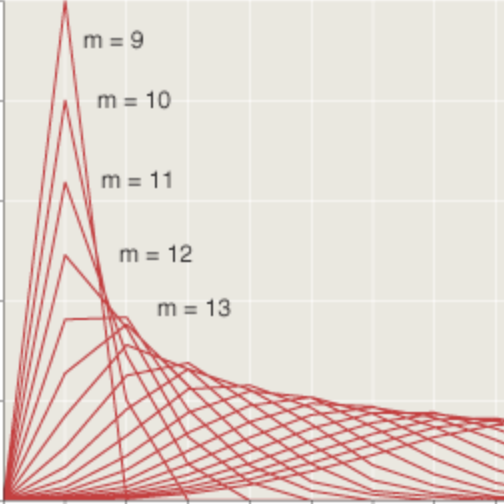Try a Little Tendrilness
by Brian Hayes
Published 10 November 2013
I was in Florida for the New Horizons in Science briefings of the Council for the Advancement of Science Writing. On my way home I took a detour to hike a few miles through the Green Swamp, west of Orlando. The place lived up to its name: There’s a lot of chlorophyll out there. There are plants, and plants that live on the plants, and plants that live on the plants that live on the plants…. I had the feeling that I had better keep moving or the vines and epiphytes might grow over me, too.

Among the epiphytes, the one everybody knows is Spanish moss (Tillandsia usneoides). In the photo above the long gray beards of Spanish moss droop from the limbs of a roadside live oak tree. Spanish moss is not really moss. (It’s not Spanish, either.) It’s an angiosperm—a flowering plant—in the bromeliad family. As parasites go, it seems to be reasonably well-behaved, draping itself from the major limbs of a tree but seldom blocking the foliage. The parasites have no roots and take nothing from the host but mechanical support.

The air potato, left and above, is a relative of the yam that propagates by means of “aerial tubers.”

Vines are another matter. For these guys it’s all about upward mobility, and they’ll step on anybody to get up into the sunshine zone. The bright green leaves in the foreground of the image above belong to a vine called the air potato (Dioscorea bulbifera). Strictly speaking it’s a yam rather than a potato, but it does produce above-ground spuds (see the detail above at right). A student I met at the CASW conference in Gainesville told me there’s a spring-loaded mechanism that launches the potatoes into the treetops. I’ve not found any confirmation of that story in published sources; perhaps the student was having some fun with a city boy from up north. D. bulbifera is native to Asia and Africa and is not well liked in Florida; the student also told me about air potato roundups in Gainesville, and that part of the story is definitely true.
The inch-thick, cable-like vine in the photo above is not the stem of the air potato plant. Rather, it is an older, woody vine—probably poison ivy—that was once attached to the tree trunk at right. (The scar is still visible on the bark.) The air potato vine is slender, green and herbaceous. It twines counterclockwise around the larger vine, thereby parasitizing another parasite.

The plant in the photo above is a passionflower vine, Passiflora suberosa. I first noticed this species infiltrating a hedge on the University of Florida campus in Gainesville; in the Green Swamp I found it everywhere I looked. Like the air potato, the passionflower vine makes a living by climbing toward the light on the backs of other plants, but it goes about it in a different way. Instead of spiralling around a stem, it puts out tendrils that lash themselves to whatever supporting structure they happen to touch. The photo above shows several new tendrils at the growing tip of a vine. Note that a few of them have gotten tangled up among themselves; I’ll have more to say about this phenomenon.
In the photo below, a P. suberosa vine has successfully seized upon a twig of a nearby shrub. The tip of the tendril has tied itself into a knot resembling a clove hitch, and the rest of the tendril has become kinky, reducing its length and drawing the vine closer to the host plant. Other nearby tendrils may also latch onto the twig, strengthening the attachment.

Before we continue with this subtropical expedition, please allow me a digression. Last year Edward O. Wilson published a grumpy essay arguing that mathematics is of little use to many scientists, especially in Wilson’s own field of biology. Members of the mathematical community took umbrage, of course. (The Notices of the American Mathematical Society reprinted Wilson’s essay with a rebuttal by Edward Frenkel.) As a nonmathematician and nonbiologist I don’t have standing in this contest, but I have an opinion all the same. It strikes me that learning mathematics not only supplies tools for getting answers but also cultivates habits of mind that can lead to interesting questions. Take this equation:
\[z = \frac{a + b}{a - b}\]
If you are the least bit math-minded, you are already asking yourself, “What about the case where \(a = b\)?” Similar issues come up in computer programming. When you write a procedure to select two items at random from a sequence, you need to think about the possibility that the two items are in fact the same item.
What does all this have to do with Florida vines and tendrils? Let’s plunge deeper into the jungle.
I was walking a section of the General James A. Van Fleet State Trail, a former rail line that cuts through the swamp straight as a laser beam. (It was once part of the Seaboard Air Line Railroad—“Air Line” meaning “as the crow flies.”) Along the way, I stopped to admire the occasional butterfly. I saw birds, too, but I didn’t get the camera out in time. I spoke with other walkers, and I dodged bicycles. I wandered off the trail, got my feet wet, picked up a cargo of burs in my pant cuffs.
Left: Gulf fritillary (Agraulis vanillae). Right: zebra heliconian (Heliconius charitonius). As it happens, both of these butterflies spend their caterpillarhood munching on P. suberosa.
All the while I was puzzling over that vine whose modus vivendi is to send up a shoot, wave around in the breeze, and blindly grab hold of the first thing it touches. What bothered me about this strategy for cadging a free ride to the forest canopy was the hazard of grabbing hold of yourself—or of another vine of the same species, just as wimpy as you are. This is a case where if \(a\) leans on \(b\) for support, it’s important that \(a \ne b\). To put it another way, self-reliance is not a virtue when you’re unreliable.
Young P. suberosa vines tend to sprout in fairly dense clusters; I saw lots of them with stems a meter long and only a few centimeters apart at ground level. Very likely the stems are connected by roots or runners and are all parts of a single individual plant, or a clone. For many of the shoots, their closest neighbors were other P. suberosa vines. Under the circumstances, it appeared that the likeliest outcome is that all the vines would glom onto one another and collapse in a tangled heap.
I wondered if the plant might have some means of self-recognition that prevents or inhibits such an outcome. Animals put a lot of effort into identifying individuals, relatives, and conspecifics. We have both nervous systems and immune systems for the purpose. Why couldn’t plants do the same thing? All it would take is a substance in the cuticle of the stem that inhibits the grabbing action of the tendrils.
I can’t rule out the existence of such a mechanism. However, after some more poking around in the underbrush, I found evidence that the vines do indeed attack their own kind. In the photo below, two vines cross, and one of them has seized hold of a leaf stem on the other. Several dried and broken tendrils suggest this was not the first encounter between the two vines. I found other examples where three or more P. suberosa vines were all lashed together.

Time for a new theory, eh? One possibility is that I’m just plain wrong about the futility of vines clinging to one another. Each vine has many tendrils, and each tendril has its own chance of finding a ticket to the sky. Maybe all the vines in a connected cluster can benefit if any one of them hits the jackpot. That is, if one member finds a path upward, all the other members can follow along as well. That would totally alter the calculus of fitness. In the simplest model we might assume that each vine makes \(n\) contacts with other plants, and each contact has probability \(\alpha\) of connecting to an upward path. Further assume that all of the probabilities are independent. Then the probability that everyone gets to heaven is \(1 - (1 - \alpha)^n\), which converges to 1 as \(n\) increases, no matter how small \(\alpha\) might be.
This scheme may well explain what’s going on with P. suberosa, but I’m not entirely satisfied with it. In the first place, the assumption that all events are independent is surely bogus. Plants are not like atoms in an ideal gas, where you might reasonably assume that any two atoms have the same probability of colliding. Plants have roots. They don’t roam at random.
Second, in the probability calculation above I have implicitly assumed that \(a \ne b\), and this assumption is unjustified. A single vine can vainly try to support itself by attaching itself to itself. I submit my final photograph, documenting an act of botanical suicide in which the tendrils of a P. suberosa plant strangle one of the plant’s own leaves:

Responses from readers:
Please note: The bit-player website is no longer equipped to accept and publish comments from readers, but the author is still eager to hear from you. Send comments, criticism, compliments, or corrections to brian@bit-player.org.
Publication history
First publication: 10 November 2013
Converted to Eleventy framework: 22 April 2025




I have seen morning glory wind around other morning glory and therby reach higher than either alone.